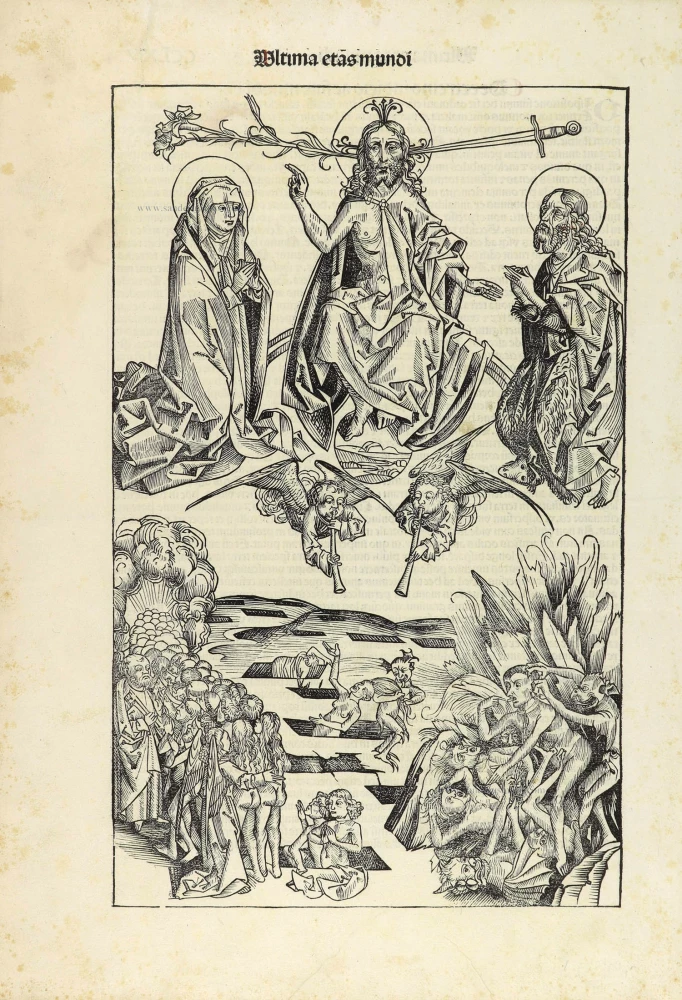The Last Judgement by Hartmann Schedel. 1493
Hartmann Schedel (Nuremberg, 1440-1514) and the Nuremberg Chronicle.
Hartmann Schedel grew up in Nuremberg and first studied liberal arts in Leipzig. He earned a doctorate in medicine in Padua in 1466, then settled in Nuremberg to practice medicine and collect books. According to an inventory done in 1498, Schedel's library contained 370 manuscripts and 670 printed books.
Schedel is best known for writing the text for the Nuremberg Chronicle, an illustrated biblical paraphrase and world history that follows the story of human history related in the Bible; it includes the histories of many important Western cities. The Nuremberg Chronicle was one of the most remarkable books of its time. It was commissioned by Sebald Schreyer (1446–1520) and Sebastian Kammermeister (1446–1503) and published in 1493 in Nuremberg. Maps in the Chronicle were the first-ever illustrations of many cities and countries. Wolgemut and Pleydenwurff, the painters, were commissioned to provide the illustrations and to take care of the layout. The large workshop of Michael Wolgemut, then Nuremberg's leading artist in various media, provided the 1,809 woodcut illustrations (including duplications).
Albrecht Dürer was an apprentice with Wolgemut from 1486 to 1489, so he may well have participated in designing some of the illustrations.
The Liber Chronicarum was first published in Latin on 12 July 1493 in the city of Nuremberg, printed by Anton Koberger, the most successful publisher in Germany. A German translation followed on 23 December 1493. An estimated 1,400 to 1,500 Latin and 700 to 1,000 German copies were published.
Due to the great success and prestige of the Chronicle, pirate editions soon appeared on the market. Johann Schönsperger (c. 1455-1521), a printer working out of Augsburg, published smaller editions of the Chronicle in 1496, 1497, and 1500 in German and Latin.
Ultima Etas Mundi.
Item Number: 29024 Authenticity Guarantee
Category: Prints > Hartmann Schedel - Liber Chronicarum
Antique image of the Last Judgement, by Hartmann Schedel.
Title: Ultima Etas Mundi.
Designer / Engraver: Michael Wohlgemut & Wilhem Pleydenwurff
Date of the first edition: 1493.
Date of this print: 1493.
Woodcut, printed on paper.
Map size: 360 x 225mm (14.17 x 8.86 inches).
Sheet size: 440 x 270mm (17.32 x 10.63 inches).
Verso: Latin text.
Condition: Excellent.
Condition Rating: A+.
Folio CCLXV (265), from: Liber Chronicarum. (= Nuremberg Chronicle). Nuremberg, Koberger, 1493.
Hartmann Schedel (Nuremberg, 1440-1514) and the Nuremberg Chronicle.
Hartmann Schedel grew up in Nuremberg and first studied liberal arts in Leipzig. He earned a doctorate in medicine in Padua in 1466, then settled in Nuremberg to practice medicine and collect books. According to an inventory done in 1498, Schedel's library contained 370 manuscripts and 670 printed books.
Schedel is best known for writing the text for the Nuremberg Chronicle, an illustrated biblical paraphrase and world history that follows the story of human history related in the Bible; it includes the histories of many important Western cities. The Nuremberg Chronicle was one of the most remarkable books of its time. It was commissioned by Sebald Schreyer (1446–1520) and Sebastian Kammermeister (1446–1503) and published in 1493 in Nuremberg. Maps in the Chronicle were the first-ever illustrations of many cities and countries. Wolgemut and Pleydenwurff, the painters, were commissioned to provide the illustrations and to take care of the layout. The large workshop of Michael Wolgemut, then Nuremberg's leading artist in various media, provided the 1,809 woodcut illustrations (including duplications).
Albrecht Dürer was an apprentice with Wolgemut from 1486 to 1489, so he may well have participated in designing some of the illustrations.
The Liber Chronicarum was first published in Latin on 12 July 1493 in the city of Nuremberg, printed by Anton Koberger, the most successful publisher in Germany. A German translation followed on 23 December 1493. An estimated 1,400 to 1,500 Latin and 700 to 1,000 German copies were published.
Due to the great success and prestige of the Chronicle, pirate editions soon appeared on the market. Johann Schönsperger (c. 1455-1521), a printer working out of Augsburg, published smaller editions of the Chronicle in 1496, 1497, and 1500 in German and Latin.

